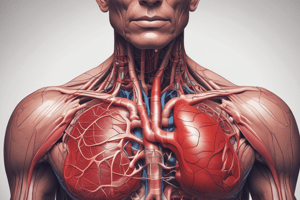Podcast
Questions and Answers
What is responsible for regulating blood flow through the circulatory system?
What is responsible for regulating blood flow through the circulatory system?
- Vasomotor tone (correct)
- Blood viscosity
- Heart rate
- Respiratory rate
What happens during times of increased demand for nutrients and oxygen?
What happens during times of increased demand for nutrients and oxygen?
- More capillary pathways are opened (correct)
- Blood vessels shrink in size
- Red blood cells decrease in number
- The heart slows down
What is the primary role of the circulatory system?
What is the primary role of the circulatory system?
- Delivering oxygen, nutrients, and hormones (correct)
- Removing carbon dioxide only
- Producing new blood cells
- Regulating body temperature
How does the cardiovascular system help the body adapt to changing demands?
How does the cardiovascular system help the body adapt to changing demands?
What is crucial for the circulatory system to maintain throughout the body?
What is crucial for the circulatory system to maintain throughout the body?
What is one primary function of the circulatory system?
What is one primary function of the circulatory system?
Which part of the circulatory system is responsible for providing oxygen-rich blood to the body?
Which part of the circulatory system is responsible for providing oxygen-rich blood to the body?
How are the systemic organs (tissues) connected in terms of blood flow?
How are the systemic organs (tissues) connected in terms of blood flow?
Where is oxygen-poor blood returned to for oxygenation in the circulatory system?
Where is oxygen-poor blood returned to for oxygenation in the circulatory system?
Which chamber of the heart connects the two main parts of the circulatory system?
Which chamber of the heart connects the two main parts of the circulatory system?
What does the circulatory system primarily use as a carrier to move material?
What does the circulatory system primarily use as a carrier to move material?
Study Notes
Introduction
The circulatory system is a complex network of blood vessels and organs that plays a crucial role in maintaining life. It is essential for transporting oxygen, nutrients, and hormones to cells throughout the body while removing waste products such as carbon dioxide. The system is composed of the heart and a network of arteries, veins, and capillaries.
Design of the Cardiovascular System
The circulatory system can be divided into two main parts: the systemic circulation and the pulmonary circulation. Both systems are connected in series through the four chambers of the heart: the left atrium, left ventricle, right atrium, and right ventricle. The systemic organs (tissues) are connected in parallel, meaning that the stroke volume ejected from the left ventricle is divided among the various organs, and a given volume of blood passes through only one organ before entering the venous outflow of the organ. Each organ experiences the same blood pressure at the entrance and can control its own blood flow independently.
Functions of the Cardiovascular System
One of the primary functions of the circulatory system is to move material (blood as the carrier) and to move heat (through tissue warming and cooling). The systemic circulation plays a key role in providing oxygen-rich blood to the body, while the pulmonary circulation ensures that oxygen-poor blood from the body is returned to the lungs for oxygenation.
Regulation of Blood Flow
Blood flow through the circulatory system is regulated by various factors, including vasomotor tone (the contraction or relaxation of smooth muscle in the walls of blood vessels) and local metabolic requirements. During times of increased demand for nutrients and especially oxygen, more capillary pathways can be opened to accommodate flowing red blood cells. The regulation of blood flow allows the circulatory system to maintain a steady supply of nutrients and oxygen to all tissues while removing waste products such as carbon dioxide.
In conclusion, the circulatory system is an intricate network designed to ensure the survival of every cell in the body. It plays a crucial role in delivering oxygen, nutrients, and hormones throughout the body while removing waste products. Through its design and function, the cardiovascular system enables the body to continually adapt to changing demands and maintain homeostasis.
Studying That Suits You
Use AI to generate personalized quizzes and flashcards to suit your learning preferences.
Description
Explore the intricate design and functions of the circulatory system, which is responsible for transporting essential materials throughout the body and ensuring cellular survival. Learn about the systemic and pulmonary circulations, blood flow regulation, and the role of the heart in maintaining homeostasis.




